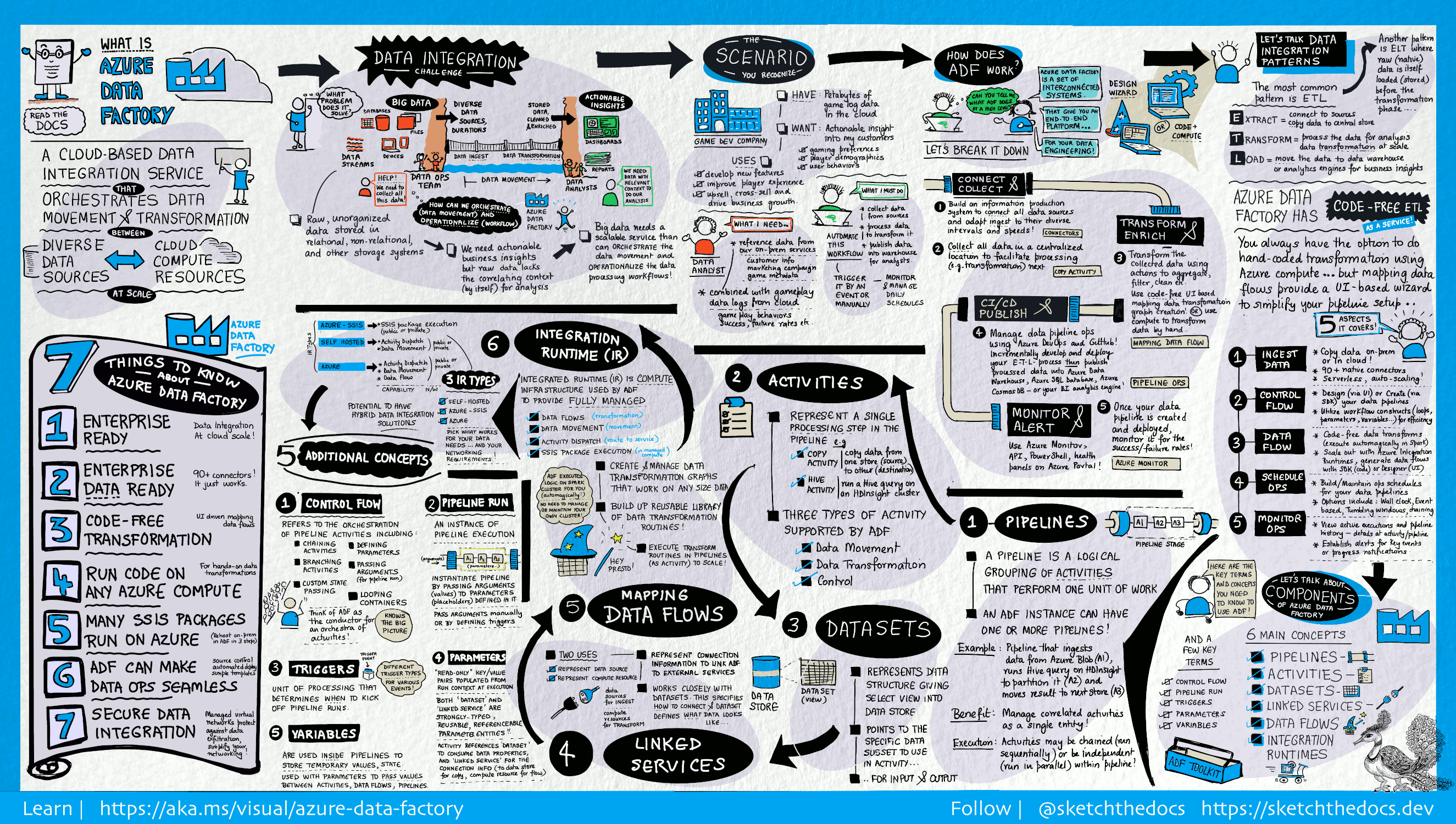In the sphere of data-centric decision making, Azure Data Factory (ADF) emerges as a pivotal component driving digital transformation. As a cloud-based data integration service offered by Microsoft Azure, ADF simplifies the creation of data-driven workflows for orchestrating and automating data movement and transformation.
ADF's capabilities range from data ingestion to transformation and integration, embodying the essence of modern data and analytics.
Let's explore Azure Data Factory's dynamic capabilities, from data ingestion to transformation and integration, and dive into how it revolutionizes the way businesses handle and interpret their data.
What is Azure Data Factory?
Azure Data Factory is a fully managed, serverless data integration tool that allows the creation, scheduling, and management of data-driven workflows.
The diagram below from Microsoft offers a detailed overview of the complete Data Factory architecture.

ADF's comprehensive architecture empowers users to ingest, prepare, transform, and integrate data from various on-premises and cloud sources, enabling the construction of meaningful insights from raw data.
Ingestion and Data Movement in ADF
Data ingestion is the first step in any data workflow, and ADF excels in this task with its vast array of connectors. ADF can ingest data from a multitude of sources, including SQL Server, Azure SQL Database, Azure Blob Storage, and Cosmos DB, to name a few. The support extends to popular cloud-based data warehouses like Amazon Redshift, Google BigQuery, and Snowflake.
ADF’s data movement activities support both batch and real-time data transfer, giving you the flexibility to handle data as your business needs dictate.
Moreover, the service ensures fault tolerance and reliable data transfer with its robust retry mechanism and self-healing functionalities.
Data Transformation with ADF
Once data is ingested, it often requires transformation to prepare it for analysis. ADF's Mapping Data Flow feature allows for visual design of data transformation logic without the need for hand-written code. This feature supports a wide range of transformations like filtering, sorting, aggregating, and joining datasets, helping you shape your data as required.
For advanced transformations, ADF provides integration with Azure Databricks and HDInsight, allowing you to leverage the power of big data and machine learning in your data workflows.
The flexibility extends to executing SSIS packages in the cloud, ensuring smooth migration from on-premises SQL Server data warehouses.
Data Integration and Pipelines in ADF
Data integration is where ADF truly shines. ADF pipelines help in orchestrating complex data workflows with control flow activities, enabling you to manage the sequence of data movement and transformation tasks efficiently.
The dynamic capability of ADF allows parameters in pipelines, making them reusable across different datasets. Additionally, it provides rich monitoring and management capabilities that give complete control over your data workflows.
You can monitor real-time pipeline performance, rerun failed pipelines, and receive alerts on your mobile or via email.
Azure Data Factory and Enterprise Security
Azure Data Factory is committed to providing enterprise-grade security and compliance, ensuring the privacy and protection of your data. It supports data encryption both at rest and in transit, safeguarding sensitive data from unauthorized access.
Furthermore, ADF is compliant with various global and industry-specific compliance standards such as GDPR, HIPAA, and ISO, demonstrating its commitment to privacy, security, and compliance.
The Future of Data Workflows with Azure Data Factory
The growing data volumes and complexity require powerful data integration tools like Azure Data Factory. ADF's dynamic capabilities in data ingestion, transformation, and integration, coupled with its robust security and compliance, make it an excellent choice for businesses aiming to drive insights from their data.
As Azure continues to evolve, we can expect even more capabilities and enhancements to ADF, pushing the boundaries of what is possible with data-driven workflows.
By leveraging Azure Data Factory, businesses can harness their data's true power, deriving meaningful insights, and making more informed decisions.
To learn more about the cost savings and business benefits enabled by Microsoft Azure, download the Forrester eBook on The Total Economic Impact of Microsoft Azure Machine Learning and see how enterprises are leveraging next-generation MLOps platforms to democratize and operationalize AI.




